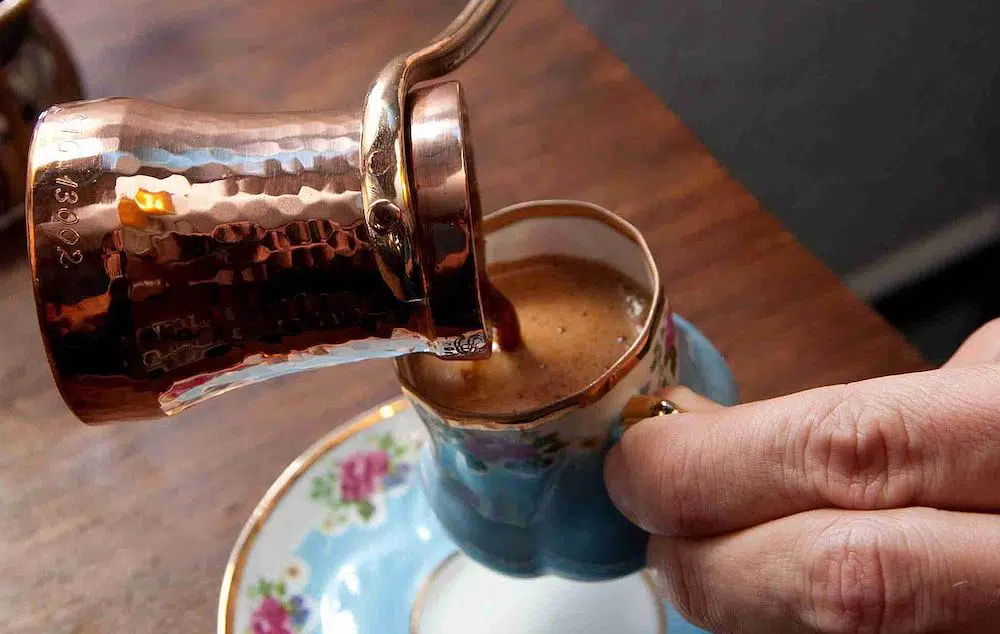
The reading of fortunes in the grinds of a Greek coffee cup is a centuries-long tradition, making coffee cup reading an act that ranges from a few minutes of fun to great (or ominous) expectations for one’s future.
The art of tasseography or tasseomancy (kafemandeia in Greek), or reading one’s fortune in the remnants of a drink from a cup, originates from China and is centuries old.
The Chinese “read” the tea leaves left at the bottom of a cup, and the Greeks “read” the grinds remaining at the bottom of a cup of Greek coffee.
Coffee cup reading by the fortune teller, or “kafetzou” (καφετζού), is based on the idea that a person’s emotional, mental, and physical condition affects the shapes formed in the coffee residue.
The vague images formed on the sides and bottom of a coffee cup are symbols that reveal something about the person and show things that might happen—or not happen—in the future. There is a whole line of symbols that (mostly) older Greek ladies can read in a coffee cup.
The Greek tradition of reading fortunes in coffee
Greek tradition has it that single young women would go to the coffee cup reader to find out if there is a future groom in line for her. Young men would also ask fortune tellers if they would find good jobs that would help them in starting families. Overall, much like reading your horoscope, people mostly care about what the future holds for them in regards to love and money.
In these times of economic crisis, certain Greeks have turned to coffee cup readers to see what the future holds for them, mostly on financial matters.
The tradition has faded over the past three decades and has become outdated. Also, many women were afraid to say that they went to a coffee reader because that would mean they had problems.
Nowadays, though, the tradition has made a comeback, and it is considered a fun and interesting event.
Steps to read your fortune in a Greek coffee cup
The steps to reading the residue of a Greek coffee cup yourself are outlined in a book called I Tyhi Mas Sto Flitzani (or Fortune in a Coffee Cup: Divination With Coffee Grounds), written by a woman who uses the pen-name “Sophia,” which also means wisdom in Greek.
Step one
The Greek coffee should be brewed in the traditional long-handled “briki” and served in a small cup. If one wants answers to a specific question, they should be focused on the issue while sipping the brew at a leisurely pace. Overall, it’s important to enjoy the experience and maintain an open mind.
Step two
Once the coffee is finished, the cup should be held facing out on its side and be turned three times clockwise while spilling out the sludge and simultaneously spreading it around the entire surface of the cup. Whatever excess remains should be poured out from the side where the cup-handle is. The cup should then be overturned onto a napkin and left for a few minutes. Take this moment to take a deep breath and “read” what is in the cup.
Step three
Overturn your cup and hold it upright. Keep an open mind and don’t try too hard to see things. If you see something that looks like one particular symbol, but it is unclear, you’re probably right. How you interpret things is up to you.
What looks like an eagle without feet to you may be a flying donkey to someone else— asking for a second opinion is a good option if you’re unsure. Oftentimes, the most important messages appear surprisingly clear.
Animals, initials, buildings, natural landmarks such as rivers, lakes, or trees and many other things known to the human eye, such as a spoon or a bicycle, can all be found in the cup.
Generally, the bottom part of the cup represents people, situations, or ideas from your past while the middle part on the sides of the cup represents the present, Furthermore, the top part indicates what’s approaching in the future. A symbol can have different meanings depending on its placement in the cup.
See all the latest news from Greece and the world at Greekreporter.com. Contact our newsroom to report an update or send your story, photos and videos. Follow GR on Google News and subscribe here to our daily email!



